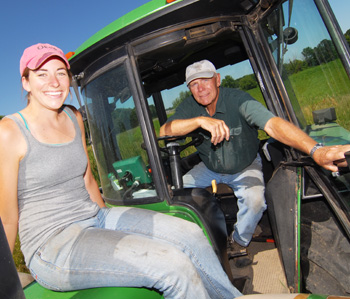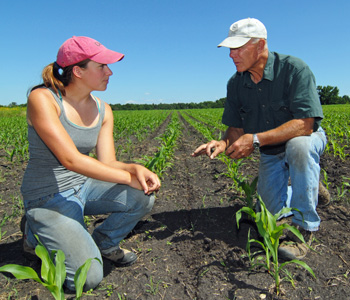Note: This article is over a year old and information contained in it may no longer be accurate. Please use the contact information in the lower-left corner to verify any information in this article.
Fieldwork cultivates corn and cleaner water
July 8, 2011
 After graduating from St. Olaf in May, Rebecca Spurr '11 hit the fields. Combining her passion for sustainability with real-world practicality, she is spending her summer planting soybeans, driving a tractor, and spreading mulch on Dave Legvold's local farm.
After graduating from St. Olaf in May, Rebecca Spurr '11 hit the fields. Combining her passion for sustainability with real-world practicality, she is spending her summer planting soybeans, driving a tractor, and spreading mulch on Dave Legvold's local farm.
The partnership was first established last fall when Spurr conducted research on Legvold's land for her Field Ecology class, a relevant course for her biology and environmental science majors that is taught by Professor of Biology Kathy Shea. Part of Legvold's farming operation is on land owned by St. Olaf, and he is constantly trying to improve his farming techniques for better efficiency and environmental sustainability. Over the course of a semester, Spurr worked with him to develop a fertilization technique that would be less harmful to local water quality without sacrificing efficiency or crop yield.
"Because we live in such an agricultural area, the way farmers go about their farming has a big impact on the health of our waterways and general environment," she says. Legvold credits Spurr's ability to adapt and be flexible to her liberal arts education: "She's able to approach novel situations and find new solutions and perspectives."
Sustainable solutions
Nitrogen fertilizer increases corn crop yield. But is a source for concern when it gets washed into waterways, where it increases algae growth. The algae decomposition process uses oxygen, causing the water to become hypoxic and unfit for natural life. The "dead zone" in the Gulf of Mexico at the mouth of the Mississippi river is one of these hypoxic areas, and agricultural nitrogen is often blamed as the cause.
"My research was intended to help Dave improve his nitrogen management plan by allowing him to see how his actions were impacting his land," Spurr says.
 |
| New alumna Rebecca Spurr '11 and Northfield farmer Dave Legvold inspect the shallow track for nitrogen cut by Legvold in one of his fields. Legvold says Spurr's research is "much more applicable" to his operation than farmers' traditional guides for fertilizing. |
To do so, she collected data over the course of a semester that showed how different amounts and methods of applying nitrogen fertilizer impacted the soil properties, nutrients, and economic returns from the corn crop. She also looked at the concentrations of nitrate in the actual cornstalks to determine if they had too little, enough, or too much nitrogen available during the growing process.
One component of the project proved to be particularly interesting. After experimenting with various fertilizer application methods, Spurr discovered that injecting the nitrogen into the ground at the base of the plant worked better than dribbling the fertilizer onto the surface of the soil. This technique resulted in a higher crop yield and profit, and was also a more efficient use of the fertilizer. Legvold used this information and other data that Spurr collected to determine how and in what amounts he would apply nitrogen this year.
In addition to sharing her research with Legvold and her Field Ecology class, Spurr has presented her findings to The Basin Alliance of the Lower Mississippi in Minnesota, and the Minnesota Groundwater Association.
